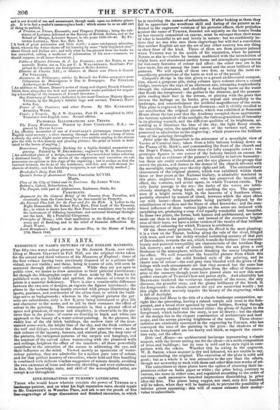FINE ARTS.
EXHIBITION OF NASH'S PICTURES OF OLD ENGLISH MANSIONS.
TEE fifty-two water-colour pictures by Mr. JOSEPH Nam, now exhi- biting at Messrs. GRAVES'S in Pall Mall, are the original views taken for the second and third volumes of his Mansions of England those of the first volume having been previously disposed of to a private indi- vidual, are not visible ; and these, being in course of sale, will soon be scattered through different collections. While they are yet open to public view, we desire to draw attention to their pictorial excellences ; for though the lithographic copies of them made by Mr. NASH for his published work are faithful and spirited, the absence of colour in the prints is a material deficiency. There is also a considerable difference between the two sets of designs, as regards the figures introduced ; the plates in the volume being mostly crowded with groups illustrating the sports, pastimes, and ceremonies of the olden time, to which the build- ings serve as backgrounds ; whereas in the original pictures the per• sons are subordinate, only a few figures being introduced to give life and character to the scene, and to aid by their costumes the effect of colour in the painting. The consequence is, that a greater effect of space and grandeur, of repose and simplicity, is observable in the pic- tures than in the prints : of course no drawing in black and white can approach to the beauty of a water-colour painting. In the pictures, the ruddy hue of the old brick buildings, the mellow tints of the time- stained stone-work, the bright blue of the sky, and the fresh verdure of the turf and foliage, increase the charm of the exterior views ; as the rich colours of the tapestry, banners, and stained glass, the deep tone of the pictures, the variegated patterns of the carpets and hangings, and the contrast of the carved oaken wainscoting with the plastered walls and ceilings, heighten the effect of the interiors : all these powerfully contribute to the attraction of the scenes in addressing the eye, and their influence on the mind. Viewed merely as specimens of water- colour painting, they are admirable for a modest pure tone of colour, and for that perfect mastery of execution, where bold and free handling is combined with delicate touches suggestive of minute details, avoiding the two extremes of loose and slovenly sketching and over-elaboration : in fine, the knowledge, taste, and skill of the accomplished artist, are conspitUNIS throughout.


























 Previous page
Previous page